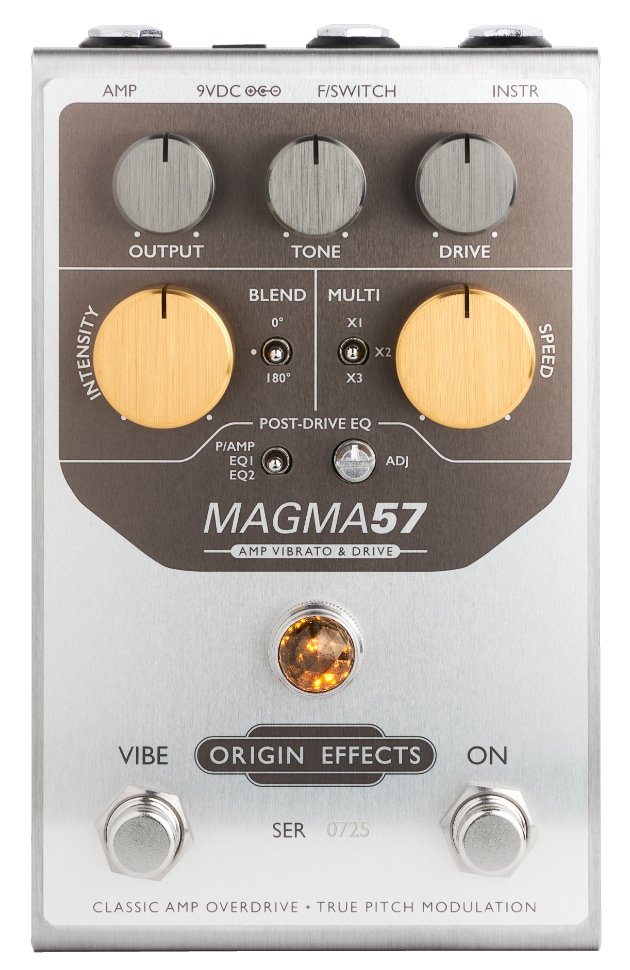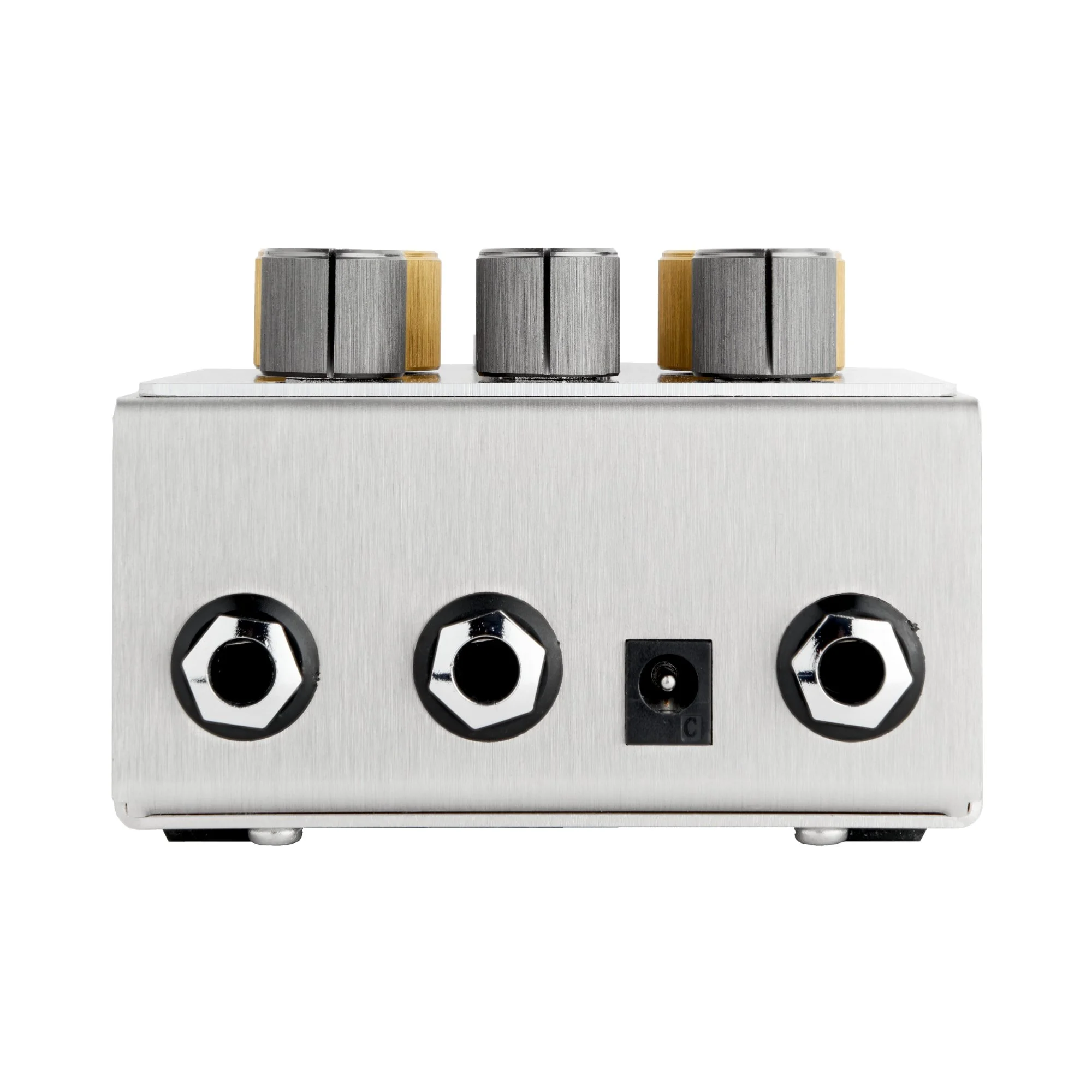I Was Using It Wrong. The Origin Effects MAGMA57
Much of learning comes from making mistakes. What I refer to as wrong, is not technically wrong per se, but was leaving me feeling with a serious case of lunch bag letdown. When I got my Origin Effects Magma57 a while back, I used it like an overdrive pedal into a clean amp. In fact, there are two EQ selections specifically for that. But it sounded MEH. I have played through current Magnatone amps and I wasn’t hearing that. Yes the true and finally properly named Vibrato was very good, but I was not getting a sense of the amp itself, and that was a gap.
As I have been recently diving deep into pedal amps, I realized that the MAGMA57 is in fact one of those. Sure you can use it as an overdrive with vibrato, but I was not getting the Magnatone sound that I had hoped for. So I started fresh, pulling it off the pedal board where it had been languishing and moved it to the studio desk as the last piece of kit before the input on my interfaces. Woohoo! Now that was more like it!
Discovering the Sound
The MAGMA57 has a three way post EQ switch. Position EQ1 applies a filter when using the pedal with a blackface style Fender amp and EQ2 applies a filter when using a Marshall style amp. There is a small adjustment control to use if the sound is too bright or too wooly. They work fine, but again, I was unimpressed. I had not used the PRE setting which is designed (and documented as such) to use with FRFR speakers or into a recording desk. By going that route and not using a guitar amp at all, I have found the magic of the MAGMA57. Do note that in this case, Origin Effects recommends using a speaker simulator because that is not part of what the pedal does. I chose an OX Stomp for this purpose, although I could have used any IR based cabinet simulator in the DAW. I chose the OX Stomp because it can work into the DAW but also into an FRFR cabinet.
How It Works
This unit is an all analog device that emulates the sound of an original Magnatone Model 213 Troubadour. The Troubadour is similar to an old Fender Tweed, but instead of the tone knob only cutting, on the Magnatone and on the MAGMA57 the tone control can both boost AND cut. When the right footswitch is ON, you have that amp and use the top controls to get the core amp tone that you want. It’s pretty straightforward. The Drive knob is acting like a non-master volume amp so you can get a range of lovely clean to decent dirt. The tone knob does as described with the bonus of being able to boost highs. The output knob controls the overall output level, so you can nail the Drive and still keep the output level usable. When active, the jewel indicator lights red. The red indicates that you are using the device in only its amplifier mode.
The gold colour knobs bring in the Vibrato from the Magnatone 260 and 280 model amplifiers. Unlike Fender labelled vibratos which are not vibratos at all, but are instead really nice tremolos for those who like that kind of thing, the MAGMA57 is real vibrato, meaning pitch shifting. The right control labelled Speed controls <surprise> the speed of the vibrato, A microswitch allows the player to select from three different speed ranges. If you use the Vibrato in tap tempo mode, the speed range switches act as tempo multipliers.
The Intensity knob controls the depth or <surprise> the intensity of the Vibrato effect from subtle to very heavy. To allow for further adjustment the Blend microswitch offers three options. In the OFF position, you get the Vibrato as in the Magnatone 260. In the zero degree setting, the wet and dry signals are in phase creating a chorus like sound as one would find in the chorus setting of an old Uni-Vibe. The 180 degree setting combines the wet and dry signal out of phase. This is a unique thing to the MAGMA57 and produces a rather different chorus effect.
The MAGMA57 should be used with a dedicated power supply that can deliver a minimum of 9V and 100mA.
The jacks are all top mounted (hoorah!). There is an input jack, an output jack, the power inlet and a jack for a TRS footswitch that if used uses tip to turn the unit on or off and ring to turn the Vibrato on or off. For tap tempo, the footswitch is required.
My Own Use
How I use the unit works for me. You will find what works best for you. First I wanted the amp sound of the old Magnatone amplifier. Second, I wanted true Vibrato and my preference in general is that a little goes a long way to widen the sound field and open things up without sounding over effected.
Example Sounds
I set the MAGMA57 on the desk and plugged the guitar into it directly. From the output of the MAGMA57 I went to the input of the UA OX Stomp choosing a 2x12 cabinet option. From the output of the OX Stomp, I ran to the Line In of a UA Apollo Twin X interface and recorded in UA LUNA with an API Channel Strip in the UNISON slot. I used the API Bus Compressor in the Mastering section.
The guitar is a semi-hollow Stratocaster, pickup selector in the middle position, all knobs at ten. The first clip is the MAGMA57 in a clean setting. The second has the Drive turned up and the Output down to give the overdriven 6V6 tone while keeping levels even. The third through fifth clips go back to clean with Vibe on, Intensity at 3, speed at noon. The third has the Blend switch at normal, the second has the switch at zero degrees and the third has the switch at 180 degrees. The final three shorts go back to Blend at Normal and use the Multi switch at X1, X2 and X3 to show the Multiplier effect on Vibrato speed.
As noted, I used a UA OX Stomp for cabinet, speaker and microphone emulation. The Cab and Speakers are a Fender Blackface Twin and the microphones are a 414 Condenser and a 121 Ribbon on the cabinet, with a pair of condensers (Sennheiser and U67) for the room mics, with a bit of reverb thrown in in the OX Stomp
Wrapping Up
This exercise has changed my perspective on the MAGMA57. Whereas in the past it was an ok light drive and vibrato pedal, it is now delivering what I expected it to do. I am using it as an amp in the studio and use the OX Stomp, or Two Notes Wall of Sound for microphone, cabinet and speaker emulations. In this case, I am thrilled and would now look at some other Origin Effects pedals in this genre. There is the Deluxe 61 based on Fender’s brown Deluxe, the Bassrig 64 which combines a Fender Showman and Bassman amplifier and the Bassrig Super Vintage which emulates the wonderful Ampeg SVT.
If you are looking for products from Origin Effects, or any other more boutique pedal, the place to go is Electric Mojo Guitars. The owner is a terrific person and the company is completely attuned to the needs of the serious musician. Heck if you want a real Magnatone amp, you can order one there as well. I recommend this shop highly. And now that I have figured out how not to use it “wrong”, I really like the MAGMA57 and recommend it too
Please support the channel yourself by becoming a member on Patreon. Send in questions or post comments, I read and respond to all. Thanks as always. I’m Ross Chevalier and we will speak again soon..


